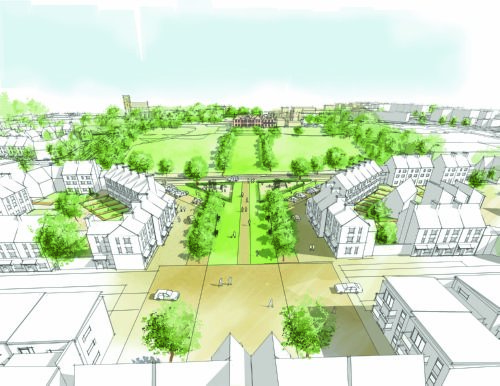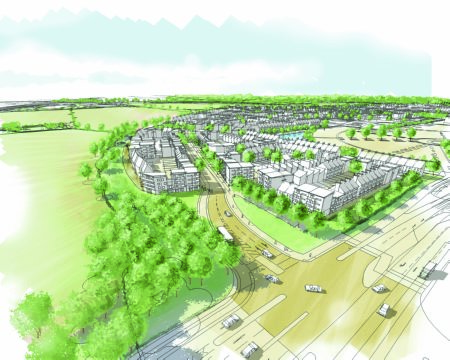 The first phase of 1,200 homes planned at Trumpington Meadows, adjacent to Trumpington Village, is well underway. Trumpington Meadows Land Company Limited, a joint venture between Grosvenor and Universities Superannuation Scheme (USS), has contracted with leading house builder Barratt to complete the phase, which began in autumn 2010.
The first phase of 1,200 homes planned at Trumpington Meadows, adjacent to Trumpington Village, is well underway. Trumpington Meadows Land Company Limited, a joint venture between Grosvenor and Universities Superannuation Scheme (USS), has contracted with leading house builder Barratt to complete the phase, which began in autumn 2010.
The aim of the Trumpington Meadows project is to create an appealing, distinctive and sustainable place to live, with a range of different sizes and types of homes, as well as integrated amenities. The development benefits from proximity to the existing village community at Trumpington with views of the village, Anstey Hall and the surrounding countryside. In addition, the area provides easy access into Cambridge city centre via road links and a Park and Ride scheme.
Keith Parrett, managing director of Barratt Eastern Counties, said: “We are very excited to be involved with this major redevelopment in Trumpington, Cambridge. Working with our partners Grosvenor and USS we look forward to delivering a place where people will want and aspire to live.”
The Design Code for Trumpington Meadows was unanimously approved in June 2010 by members of Cambridge City Council, South Cambridge District Council and Cambridgeshire County, representing the culmination of months of detailed work and consultation between architects, planners and local residents.
The Cambridge area is expected to experience a substantial rate of growth over the next 10-15 years; subsequently the joint authorities felt it was essential that the new developments were well designed and laid out. Therefore, in collaboration with Grosvenor and USS, a Design Code was agreed to be the method to achieve the vision for the project.
Trumpington Meadows splits into four quarters: ‘Village’, ‘Gateway’, ‘Urban’ and Riverside. Each of these areas has its own distinct character and will be distinguished by the design, height and density of the buildings. Bedfordshire Pilgrims Housing Association will provide 480 homes with funding provided by the first of the Cambridge Challenge pilot initiatives promoted by the Housing and Communities Agency, and 40% of the housing will be affordable.
Planning consent for the 154 ha Trumpington Meadows scheme was granted in October 2009. A spokesperson for Trumpington Meadows Land Company said: “We have been working on Trumpington Meadows for a number of years, seeing the project from site acquisition to planning approval. Securing Barratt as the first house builder partner is a key milestone. Their commitment to award winning architecture with a high level of build quality is in-keeping with our aspirations for Trumpington Meadows.”
The scheme also includes a 60 hectare country park that will be run by the Wildlife Trust, whilst additional facilities comprise a new primary school, recreational space, a network of footpaths and cycleways and allotments.
Prehistoric finds at Trumpington Meadows
Remains up to 5000 years old have been discovered at the Trumpington Meadows site by a team of archaeologists from the Cambridge Archaeological Unit.
Project Manager Alison Dickens said: “The archaeology seems to fall into two main periods – the mid to late Neolithic (about 4000 to 5000 years ago) from which we have two rare and important burial monuments, and the Iron Age (around 2100 to 2500 years ago) from which we have hundreds of pits spread across the site. That’s not all we have, of course, but they’re the most important.”
The Neolithic monuments are in the form of ring ditches, the largest of which has a double ring and the remains of at least four people buried in a pit in the centre of it. The Iron Age pits provide evidence of a communal gathering point in the landscape, including the physical remains of a wide array of activities including those commonly associated with ‘every-day’ domestic occupation (weaving, grinding, butchery, cooking and serving, metalworking etc) and those concerning mortuary rites and the disposal of the dead.
The site lies in a landscape that has seen significant investigation over the last few years with evidence from the Neolithic, Bronze Ages, Iron Age and Roman periods telling the story of a complex and historically valuable area.
MJ Electrical Services
MJ Electrical Services Limited recommended to J Breheny Contractors Ltd by the John Lewis Partnership carried out the installation of the control barriers and automated gates on the service road to the John Lewis distribution warehouse. The works included intercom control from remote site, access control, CCTV, fire alarm interface systems and electrical supplies associated with the service road barriers and gates.






